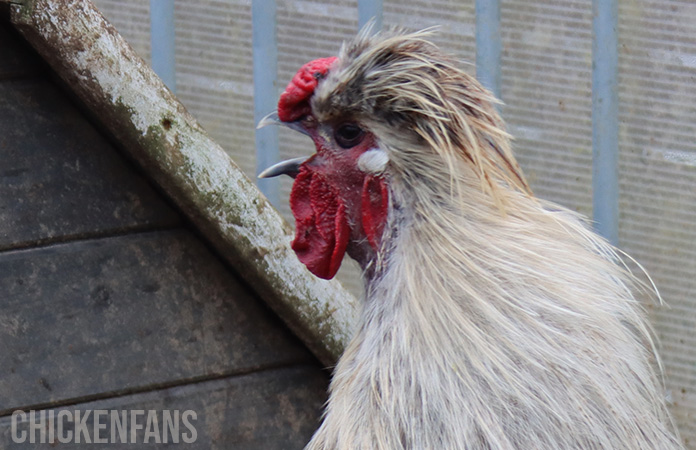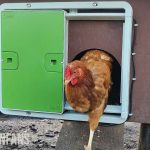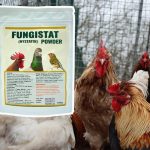Chickens With Afros: Who Has The Poofiest Hairdo?

Chickens with afros are just some of the more popular and stylish birds out there. The crests of feathers that adorn the top of their heads will certainly grab anyone’s attention, as these give off a regal vibe to them. They also go by crested chickens and are a favorite in the chicken community.
If you want to raise a chicken that sports this unique hairdo, here are some birds that you need to look closely at. Each of them brings a certain flair and pizzazz to the table that will make you love them even more.
- Polish
- Sultan
- Appenzeller Spitzhauben
- Pavlovskaya
- Silkies
- Cream Legbar
- Crevecoeur
- Houdan
- Frizzle Chickens
1. Polish
When it comes to a poofy hairdo, Polish chickens sport a very distinct and quirky afro. Some even sport a crest of feathers similar to that of a bowl hat, while others have more of a rocker mentality like they’re about to form a band and perform concerts in your backyard.

The Polish chicken is easily the most popular crested chicken among its peers and is widely available from breeders. There was also a time when this breed was an excellent egg producer, mainly in France.
And while these birds were bred initially for that purpose, they gradually fell out of favor with commercial breeds over time. Nowadays, most people keep them as ornamental birds, but they are still a fairly good egg layer.
While their crest of feathers’ puffiness makes them look adorable, they don’t offer any kind of protection against predators. Rather, they are a hindrance because it obscures their visibility. This makes them quite easy to catch, even for kids.
Luckily, these birds are docile and gentle when it comes to children, so they make great backyard pets. However, they scare easily and often hide in some of the most random places. But that adds more to their charm for most people.
2. Sultan
If you’re in the market for a chicken with a poofy hairdo, class, and general wow factor, consider the rare and unique Turkish chicken breed Sultan. Its original Turkish name, Sarai-Tavuk, translates to fowls of the palace, making this bird a common staple in royal households.

The Sultan chicken breed sports a beautiful appearance as they have feathered feet, a puffy crest, and a long tail. Today, many breeders raise this unique breed of chicken for international showings and competition.
Sultan chickens come in various colors: white, black, and blue. However, the most popular variety among the three is the white one with blue legs, which has a regal appearance.
These birds are easy to handle because of their docile nature and friendly demeanor. However, they require a lot of care to keep them clean and happy and are therefore not the most beginner-friendly breed.
3. Appenzeller Spitzhauben
There are two varieties of Appenzeller chicken: the Barthuhner and the Spotzhauben. However, the one that sports a feather crest is the latter. The breed itself is only one of two that originate from Switzerland, the other being the Schweizer.
Compared to a Polish chicken’s poofy crest, the Spitzhauben sports one that’s on the smaller side. However, it more than makes up for it in style, as its feathers stand up more and show off a ton of personality.
These birds don’t particularly do well in confined environments because of their upbringing in the mountains. Instead, they do better in a free-range environment and are great foragers and scavengers. Though quite small and light, they are quite the adventurous breed, as they won’t hesitate to roost in high places, such as trees or on rooftops.
Additionally, the Spitzhauben are hardy birds that can tolerate any sort of climate. They are exceptionally cold-hardy but can also tolerate hot and humid temperatures, as long as you provide them with plenty of shade and water.
4. Pavlovskaya
One of the more unique and rare breeds on this list, the Pavlovskaya, is not a well-known breed compared to the rest. However, it still has a rich history that stacks well with the rest, and its striking feather crest makes them lovely birds to care for.

This breed of chicken originated in Russia, specifically in a village called Pavlovo. Breeders affectionately call these gentle birds Pavlovs, or Pavs for short.
They have a feather crest similar to Polish chickens, just less poofy and a bit more upright. This gives them a memorable look.
Many consider this breed a chicken masterpiece from Russia in the eighteenth century. However, their numbers were already in steep decline from then on. By the late 1880s, no more Pavlovskaya hens existed, and only two roosters remained, one infertile.
Despite the circumstances, this breed came back from the brink of extinction and still exists today. However, if you plan to raise one of these calm and docile birds in your backyard, you must be patient.
They aren’t expensive to procure, but the long wait time will test your patience. It can take up to a year before you can get your hands on one, and they’re not particularly great at providing either eggs or meat.

However, if you want to raise a crested bird in your backyard with a rich history, consider getting a Pavlov and letting other people know more about them.
5. Silkies
One of the more popular and well-known crested fowls are Silkies. Hailing from China, these small birds are famous for their fluffy appearance and black skin. Their plumage comes in a variety of colors, but the color that most people remember them by is white.

The reason Silkies got their name is because of how soft and fluffy their plumage is, with many likening it to silk and fur. There were even early myths about them, detailing that these birds were the offspring of both a chicken and a rabbit due to their plumage.
Besides the afro on their heads, some varieties of this bird can also grow a beard of feathers. They are fluffy balls just waiting for someone to cuddle them.
Many people now keep these birds as either ornamental fowl or pets at home. They are very friendly and easy to handle, making them a popular breed among children.
They are cold-hardy birds as well, able to survive the winter months remarkably well. However, they don’t do quite as well in hot or humid and muddy environments, especially in areas where the ground is always wet. That’s because their feathers are similar to down feathers in chicks, making them susceptible to moisture.

Additionally, while they are not great egg layers, they are exceptional brooders. Plenty of breeders keep these birds around to sit on other hens’ eggs, especially those not particularly great brooders.
6. Cream Legbar
The Cream Legbar is a popular and unique variety of Legbar created in the late 1920s. Many refer to this variety as the Crested Cream Legbar because of the feathers adorning the top of its head, not seen in the other varieties.

This particular variety of chicken is also an autosexing breed. You can tell the male chicks from the female chicks after a few hours of them hatching out of their eggs. By identifying the color and patterns of their down, you can easily tell what the gender of the chick is.
Besides their unique appearance, the Cream Legbar produces some of the most beautiful eggs. They are pastel blue and are the sole reason why plenty of people want to raise one. It’s because of the eggs’ color that they survived extinction in the 1970s, as many people took an interest in the chicken because of it.
For those who want to raise one in their backyard, these docile birds are low-maintenance and exceptional foragers. They are also very active, even at night. So you might want to put some fencing around your precious plants at home if you want to take care of them.
7. Crevecoeur
The Crevecoeur is an endangered breed of chicken hailing from France, and it is one of the oldest breeds hailing from that country. This breed’s name translates to a broken heart and comes from the commune of Crevecoeur-en-Auge. The name stems from the infertile land, which made it difficult for peasants at the time to raise crops and broke their hearts in the process.

During the First and Second World Wars, the population of this breed suffered greatly and virtually disappeared for a time until recovery efforts to save the breed began in 1976. The reason for its near extinction was that, during the Second World War, the German army that reached Normandy nearly ate the entire population of the birds within two years, save for a few that some farmers managed to hide.
Crevecoeur chickens have a poofy crest on top of their heads and a beard. They also have a V-shaped comb and come in a variety of colors: black, blue, white, and cuckoo.
These birds are easy to handle and can forage for themselves, although many consider confinement best to shield them from harsh weather. Although a dual-purpose breed, these birds can only lay around 120 eggs per year and are better as table birds because of their meat.
8. Houdan
Like the Crevecoeur, the Houdan is an old breed of chicken hailing from France. They have a similar appearance to the Crevecoeur as well. However, the Houdan sports a butterfly-shaped comb and has five toes on each foot, compared to four on a Crevecoeur.
These birds have a calm and friendly temperament, making them great pets for breeders to raise around their children. Additionally, this is also a dual-purpose breed that rivals that of the White Leghorn when it comes to both egg and meat production.
The most distinct varieties are the ones that have black-mottled plumage with white spotting. But they also come in white and lavender, thus making them great show birds.
9. Frizzle Chicken
Last but certainly not least are the Frizzle chickens. These adorable birds differ greatly from the rest on this list because they are not a breed of chicken. Instead, most classify them as a chicken variety.

While some European countries and Australia consider these birds a distinct breed, the United States does not and instead classifies them according to the particular breed that they belong to. Some examples of chicken breeds that could spawn a Frizzle variety are the Polish, Pekin, Silkies, and Cochins, but in reality, all breeds are possible, even Easter Eggers!
These birds all carry the Frizzle gene, which has incomplete dominance over normal plumage. Hence, these birds have curled feathers, making them adorable and fluffy.
Although no one knows where these chickens came from, many scientists believe that the Frizzle gene originated in Asia. Countless reports of these chickens have come from that part of the world since the eighteenth century.
The reason why these birds continue to exist to this day is that plenty of breeders continue to raise chickens with the Frizzle gene for exhibitions and shows. That much says just how popular they are.

On top of that, these birds are beginner-friendly and don’t require much effort to raise. They can survive in a variety of climates and don’t require a lot of food for consumption due to their generally small stature.
Additionally, they make great pets due to their calm and friendly temperament, so you don’t have to worry about them harming the kids. Nowadays, they can easily take over the internet because they are cute and charming, making them a fan favorite.
Summary
Chickens with afros are some of the coolest and most unique birds out there. They all have a story to tell that makes them stand out from the rest. And it also doesn’t hurt that these are some of the cutest and most adorable birds that you can raise in your backyard.
There are hundreds of chicken breeds in the world! If you want to get to know them all, rare or common, heritage or hybrid, go to our ‘All Chicken Breeds & Types Worldwide: List of 500+ Breeds‘.
To learn more about chicken breeds, check out our ‘Chicken Breeds Page‘ to see every specific breed we address. Or go to our listicle breed summary on ‘The Classroom‘, or, if you’re unsure where to start, take a look at our ‘Chicken Breeds: Ultimate Beginners Guide‘.
Or, if you haven’t had enough of unique chicken breeds, check out our article, ‘10 Fluffy Chicken Breeds That Are Kid Friendly‘.
Credits Featured Image:@hensonoxney (IG






















